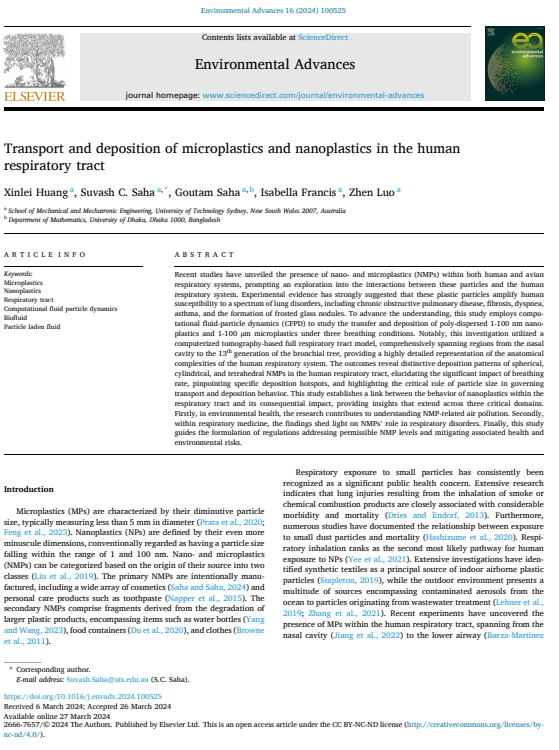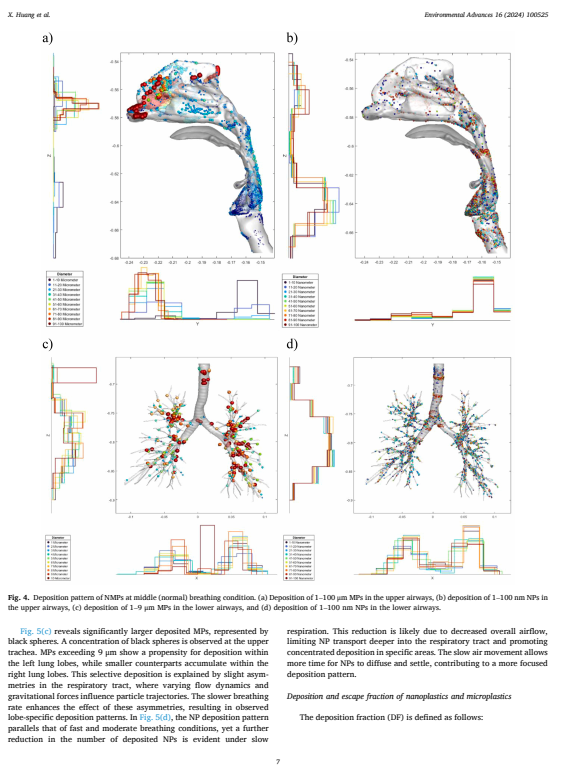인간 호흡기 내 미세플라스틱 및 나노플라스틱의 이동 및 침착
Transport and deposition of microplastics and nanoplastics in the human respiratory tract
Recent studies have unveiled the presence of nano- and microplastics (NMPs) within both human and avian respiratory systems, prompting an exploration into the interactions between these particles and the human respiratory system. Experimental evidence has strongly suggested that these plastic particles amplify human susceptibility to a spectrum of lung disorders, including chronic obstructive pulmonary disease, fibrosis, dyspnea, asthma, and the formation of frosted glass nodules.
To advance the understanding, this study employs computational fluid-particle dynamics (CFPD) to study the transfer and deposition of poly-dispersed 1-100 nm nanoplastics and 1-100 μm microplastics under three breathing conditions.
Notably, this investigation utilized a computerized tomography-based full respiratory tract model, comprehensively spanning regions from the nasal cavity to the 13th generation of the bronchial tree, providing a highly detailed representation of the anatomical complexities of the human respiratory system. The outcomes reveal distinctive deposition patterns of spherical, cylindrical, and tetrahedral NMPs in the human respiratory tract, elucidating the significant impact of breathing
rate, pinpointing specific deposition hotspots, and highlighting the critical role of particle size in governing transport and deposition behavior.
This study establishes a link between the behavior of nanoplastics within the respiratory tract and its consequential impact, providing insights that extend across three critical domains.
Firstly, in environmental health, the research contributes to understanding NMP-related air pollution. Secondly, within respiratory medicine, the findings shed light on NMPs’ role in respiratory disorders. Finally, this study guides the formulation of regulations addressing permissible NMP levels and mitigating associated health and environmental risks.

초록
최근 연구에서는 인간과 조류의 #호흡계 모두에 나노플라스틱과 미세플라스틱(NMP)이 존재한다는 사실이 밝혀졌으며, 이러한 입자와 인간의 호흡계 사이의 상호 작용에 대한 연구가 촉발되었습니다.
실험적 증거에 따르면 이러한 플라스틱 입자는 만성 폐쇄성 폐질환, 섬유증, 호흡 곤란, 천식 및 젖빛 유리 결절 형성을 비롯한 다양한 폐 질환에 대한 인간의 민감성을 증폭시키는 것으로 나타났습니다.
이해를 돕기 위해 이 연구에서는 CFPD(전산유체입자역학)를 사용하여 세 가지 호흡 조건에서 다중 분산 1~100 nm 나노플라스틱과 1~100 μm 미세플라스틱의 전달 및 증착을 연구합니다.
특히, 이 조사에서는 #비강 부터 13세대 #기관지 까지의 영역을 포괄적으로 포괄하는 컴퓨터 단층촬영 기반 전체 호흡기 모델을 활용하여 인간 호흡계의 해부학적 복잡성을 매우 자세하게 표현했습니다. 결과는 인간 호흡기관에서 구형, 원통형 및 사면체 NMP의 독특한 침착 패턴을 밝혀 호흡의 중요한 영향을 설명합니다.
속도, 특정 증착 핫스팟을 정확히 찾아내고 운송 및 증착 동작을 제어하는 데 있어 입자 크기의 중요한 역할을 강조합니다.
이 연구는 호흡기 내 나노플라스틱의 행동과 그에 따른 영향 사이의 연관성을 확립하여 세 가지 중요한 영역에 걸쳐 확장된 통찰력을 제공합니다.
첫째, #환경보건 분야에서 본 연구는 #NMP 관련 대기오염을 이해하는 데 기여합니다. 둘째, 호흡기 의학 분야에서 이번 연구 결과는 호흡기 질환에서 NMP의 역할을 밝혀줍니다. 마지막으로, 이 연구는 허용 가능한 NMP 수준을 다루고 관련 건강 및 환경 위험을 완화하는 규정의 수립을 안내합니다.
Conclusion
This study presents a groundbreaking and comprehensive investigation into the dynamics of nano- and microplastic transport and deposition throughout the human respiratory tract under diverse breathing conditions.
Key insights derived from our research are as
follows:
1. Distinct Deposition Patterns:
Noteworthy differences in deposition patterns were observed for MPs and NPs across varying breathing rates. Slower breathing rates were found to significantly enhance the deposition coverage of MPs, particularly within critical regions such as the nasal cavity, laryngopharynx, and larynx.
2. Breathing Rate Influence:
The breathing rate is a crucial factor influencing the deposition and escape dynamics of NMPs.
Faster breathing rates led to heightened deposition in the upper respiratory tract, particularly for larger MPs, whereas slower breathing facilitated deeper penetration and deposition of smaller NPs.
3. Identification of Deposition Hotspots: Specific hotspots within the
respiratory tract were identified where NMPs preferentially deposit.
Larger MPs exhibited a concentration in the anterior segment of the
nasal cavity, while both smaller NPs and MPs demonstrated a more
even distribution throughout the airway.
4. Critical Role of Particle Size:
The size of NMPs emerged as a critical determinant in governing their transport and deposition patterns.
Larger MPs displayed a tendency for rapid deposition in the upper airways, whereas smaller NPs exhibited a higher likelihood of escape
or reaching deeper airway generations.
5. Non-spherical MPs have a propensity for deeper lung penetration compared to spherical microplastics and nanoplastics, potentially leading to different health outcomes.
These findings highlight the imperative consideration of breathing rates and particle sizes in health risk assessments associated with respiratory exposure to NMPs. Such insights are essential for the development of targeted strategies aimed at mitigating potential ealth risks and ensuring effective health interventions.
결론
이 연구는 다양한 호흡 조건 하에서 인간 호흡기 전반에 걸쳐 나노 및 미세 플라스틱의 이동 및 침착 역학에 대한 획기적이고 포괄적인 조사를 제시합니다.
우리 연구에서 얻은 주요 통찰력은 다음과 같습니다.
다음과 같습니다:
1. 독특한 증착 패턴:
다양한 호흡 속도에 걸쳐 MP와 NP에 대해 증착 패턴의 주목할만한 차이가 관찰되었습니다. 느린 호흡 속도는 특히 비강, 후두인두 및 후두와 같은 중요한 부위 내에서 MP의 침착 범위를 크게 향상시키는 것으로 나타났습니다.
2. 호흡률 영향:
호흡 속도는 NMP의 증착 및 탈출 역학에 영향을 미치는 중요한 요소입니다.
호흡 속도가 빠르면 특히 MP가 클수록 상부 호흡 기관의 침착이 높아지는 반면, 호흡 속도가 느리면 작은 NP의 침투와 침착이 촉진됩니다.
3. 증착 핫스팟 식별: 증착 내의 특정 핫스팟
NMP가 우선적으로 침전되는 호흡기관이 확인되었습니다.
더 큰 MP는 전안부에 집중된 것으로 나타났습니다.
비강에 비해 작은 NP와 MP 모두 더 많은 것을 보여주었습니다.
기도 전체에 고르게 분포됩니다.
4. 입자 크기의 중요한 역할:
NMP의 크기는 운송 및 증착 패턴을 관리하는 데 중요한 결정 요인으로 나타났습니다.
MP가 클수록 상부 기도에 빠르게 침착되는 경향이 있는 반면, NP가 작을수록 탈출 가능성이 더 높습니다.
또는 더 깊은 기도 세대에 도달합니다.
5. 비구형 MP는 구형 미세플라스틱 및 나노플라스틱에 비해 폐에 더 깊게 침투하는 경향이 있어 잠재적으로 다른 건강 결과를 초래할 수 있습니다.
이러한 발견은 NMP에 대한 호흡기 노출과 관련된 건강 위험 평가에서 호흡률과 입자 크기를 필수적으로 고려해야 함을 강조합니다. 이러한 통찰력은 잠재적인 건강 위험을 완화하고 효과적인 건강 개입을 보장하기 위한 목표 전략 개발에 필수적입니다.














******************************************************************************************************
#미세플라스틱 #시험분석 기술서비스 #시험표준개발 #국제공인시험기관 #KOLAS
#시험/분석 #환경 #수질 #토양 #대기 #폐기물 #타이어 #슬러지
#식품 #음료 #벌꿀 #주류 #소금 #어패류 #해조류 #미세플라스틱분석 #미세플라스틱시험
#세탁폐수 (#미세섬유) #세탁망 #필터 #화장품 #치약 #생활화학제품
#식품용기 #티백 #젖병 #종이컵 #정수기 #젖병소독기
#표준개발 ISO/TC61/SC14, TC38, TC147/SC2&SC6 (Microplastics) Korean Delegate
IEC/TC 111/WG 3 & JWG 14 Co-Convenor
IEC 62321-3-2(#Halogen ),-10 (#PAHs ), -13(#BPA ), -14(#SCCP/MCCP ) Project leader
- 분석장비: #TEDGCMS, #microFT-IR #microRaman, #ICPMS #XRF #Combustion-IC 등
#PAHs분석 #SCCPMCCP분석 #Halogen분석
#생체시료분석 #생체미세플라스틱분석 #혈액미세플라스틱분석 #인체미세플라스틱분석
#생체시료시험 #생체미세플라스틱시험 #혈액미세플라스틱시험 #혈액미세플라스틱검사
#ISO/IEC 17025 (국제공인시험기관, KOLAS) 인정 연구소
******************************************************************************************************